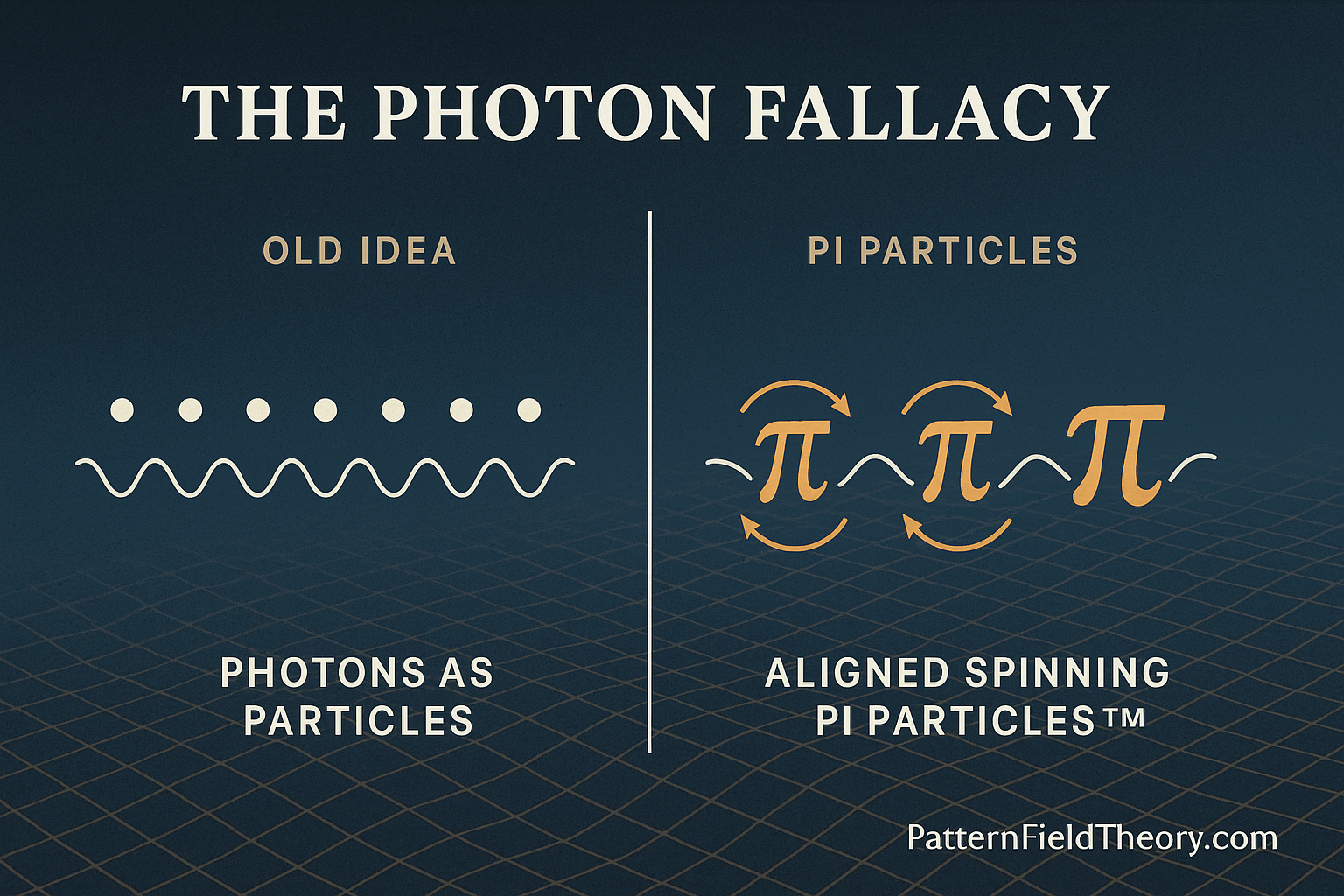The Photon Fallacy in Pattern Field Theory
A Reconsideration of the Photon as More Than a Self-Contained Particle
Last updated: 2025-10-04

Rethinking Light and PhotONS
1️⃣ The Fallacy of the Independent Photon
In mainstream physics, the photon is often treated as a fundamental particle traveling through empty space, sometimes behaving as a particle, sometimes as a wave. Pattern Field Theory (PFT™) identifies the core mistake: the assumption that the photon is a self-contained, independent entity. In PFT, the apparent duality reflects how we probe the field, not an intrinsic particle–wave contradiction.
2️⃣ Pattern Field Theory’s Position
- ✅ A photon is a pattern event (a stabilized curvature cycle) within a continuous field, not an isolated pellet in flight.
- ✅ Light is field resonance that re-forms at permissive nodes; the field carries energy and instruction continuously.
- ✅ The appearance of “a photon” arises via pattern anchoring (boundary/instrument/observer coupling), not via an object traversing void.
In PFT, the anchoring operator stabilizes the detection event. Quantization is a property of the interface with matter; the carrier is continuous.
3️⃣ Observer-Anchored Detections
The “photon hit” is the resonant node where tension and potential align under the instrument’s boundary conditions. Context selects whether the event reads wave-like or particle-like. No separate collapse axiom is required.
4️⃣ Implications for Experiments and Physics
- • Collapse replaced by anchoring at the field–matter interface.
- • Wave vs. particle outcomes are complementary readouts of the same substrate process.
- • Visibility and which-path trade-offs track the coherence budget in the medium and apparatus.
Dimensional Limits of Light and Observation
In strictly 2D mathematical spaces, full EM behavior is not realized because orthogonal field components (and their coupling to matter) require at least two perpendicular spatial axes plus time. Observation, by definition, involves interaction with matter, and coherent matter assemblies are 3D + time; consequently, observation is a 3D (or higher) operation.
| Dimension | Can Light Exist? | Can Light Be Observed? |
|---|---|---|
| 2D | Only as projections/toy models; full EM coupling is absent. | No — detectors require 3D structures. |
| 3D | Yes — full EM propagation and polarization. | Yes — all known observation occurs here. |
“Light does not manifest in 2D because observation requires 3D structural interaction. While mathematically modelable in 2D (like wavefronts), light only resolves physically through 3D interaction fields.” — James Allen
Thus, light’s measurable effects (momentum transfer, polarization, energy exchange) only fully materialize in 3D contexts. Lower-dimensional projections lack the complete interactive properties.
🧪 Field Coherence Visibility Test (Earth-Based Demonstration)
Goal: Test whether visibility follows field coherence dominance (PFT) rather than a “photon count” picture.
Design:
- Scenario A — Atmospheric baseline: Night-sky viewing under low-light conditions; record star visibility/vignetting.
- Scenario B — Local coherence saturation: Observe stars near a strong light source (shielded from glare). PFT predicts weaker resonances can be suppressed by local coherence dominance (cf. lunar viewing conditions).
- Scenario C — Isolation chamber: Dark chamber with controlled coherence spikes; modulate weaker “star” LEDs and measure visibility loss vs. coherence spikes.
Expected (PFT):
Star visibility correlates with local coherence budgets. Under intense local coherence, weaker resonances become observationally null — consistent with the pattern-anchored resonance model.
5️⃣ Summary: Reframing the Photon Fallacy
- • “Photon” = event of stabilized curvature, not a self-contained particle.
- • Anchoring by the instrument/observer stabilizes detections; the field is continuous.
- • Wave–particle outcomes arise from measurement context, not ontology.
- • Light is a field resonance guided by tension, potential, and structural permission.
Conclusion
Recasting light as resonance in a logical field dissolves the photon fallacy: measurements register anchored events, while the substrate maintains continuity. This perspective harmonizes experiments with a unified mechanism for detection, visibility, and information flow.